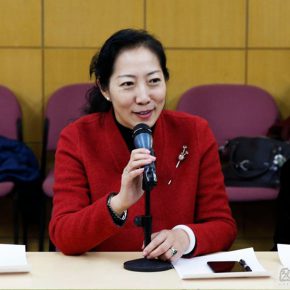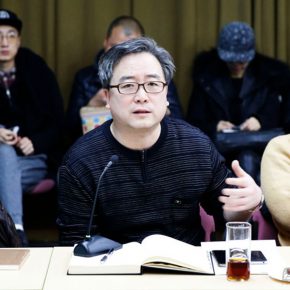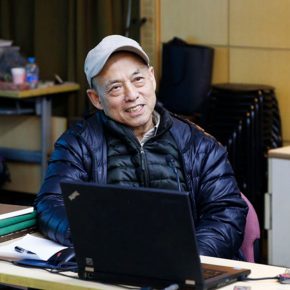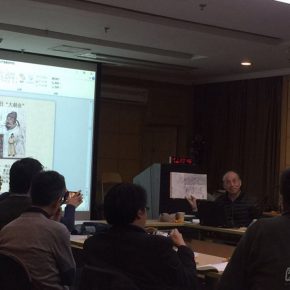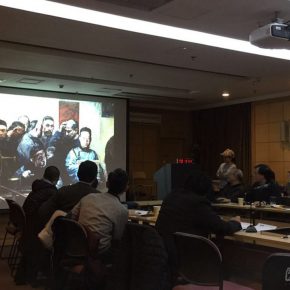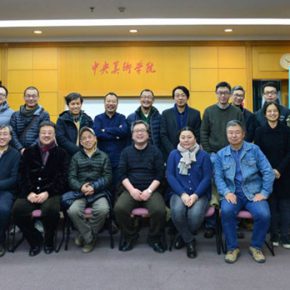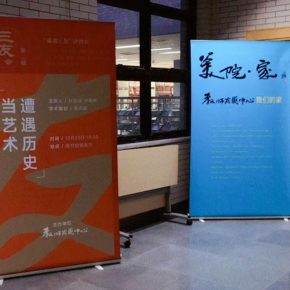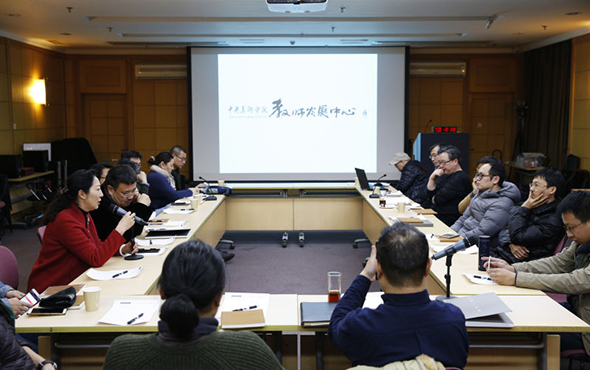
At 18:30 pm on December 29, 2016 (Thursday), a series of academic activities organized by the Teacher Development Center at CAFA – “Three Good Friends” Discussion Session Two: “When the Art Meets the History” was held at the lecture hall on the ground floor of the library. The discussion invited Prof. Sun Jingbo and Prof. Li Xiaolin to deliver a speech, on the theme of “When the Art Meets the History” to share their understanding and feelings gained in the course of engaging in the creation themed on historical paintings of Chinese civilization. Prof. Cao Qinghui served as the planner and host of the discussion, and more than thirty teachers from various disciplines participated in the discussion.
At the beginning of the lecture, Assistant to the CAFA President, Dean of the Academic Affairs Office Wang Xiaolin first introduced the purpose of the Teacher Development Center organizing a series of activities: “Teacher Development Center at CAFA” aims to assist teachers, benefitting teaching, to provide all-round support to teachers carrying out academic teaching activities, to promote an exchange in teaching and creation with the teachers from different disciplines, and create a good atmosphere for the academy to worship teaching and morality, and a platform for the majority of teachers to exchange and interact. “Three Good Friends” series of discussions mainly invite teachers to talk about their creation, through discussion with the teachers, hoping to create an academic platform for inner exchanges for the teachers to express themselves, understand their fellow teachers, focusing on the learning, together developing, while enhancing the communication of research and creation, inspiring teachers to have thoughtful inspiration, enhancing friendly exchanges between teachers. The host Prof. Cao Qinghui first reiterated the purpose and the connotation of the holding of the discussion. It was entitled “Three Good Friends”, which was extracted from Confucius’s words “There are three good friends and three bad friends. The straightforward friend, the forgiving and understanding friend, and the knowledgeable friend are good; there are three bad friends, the sinister friend, the complimentary friend and the fair-spoken friend are bad. The discussion advocated that obsolete words and expressions must be eliminated, while it supported telling the truth, against false speech, welcoming the good friends, despising the bad friends.
Sun Jingbo and the “Zhenguan Grand Meeting”?First of all, Sun praised CAFA as it had made outstanding contributions to the historical painting in China since the founding of new China, and the special historical position, and then he encouraged and hoped that young artists would inherit the creative passion of senior artists. When talking about the experience to create the mural painting entitled “Zhenguan Grand Meeting”, Sun talked about the selection of the theme, characters’ images, classics and events, the scrutiny of the building and scenes, the process of the several changes of the composition and the changes of content, while he also showed us the manuscripts drawn for the mural painting from 2012 to 2016, including the concept and textual research of the characters, accumulated in several books.
Sun said that: When an artist is engaged in the creation of historical painting, he must make the preparations as far as possible, avoiding the mistakes in the history in the course of grinding a sword in five years, I participated in a series of activities of assessment, inspection, visits and expert discussions and found that it was necessary to have a process of matching. What is this? It is a fact that some artists have a blind spot for the knowledge of history and historical painting, the process of communicating and exchanging with historians engaged in the research of etiquette and the system, clothing, weapons, instruments is the process of re-conception and remodeling of the creation. After many rounds of adjustment, some characters had been adjusted until it was determined and started to draw in March 2015. From drawing manuscripts to the completion, it spent 1 year communicating with historians, and artists had spent almost 4 or 5 years, which is a rare experience for the historical painting creation and the individual growth of the artist.
Li Xiaolin Talked about “The Rise of the Commercial Group – Shanxi Businessmen”???Prof. Li said he had a deep feeling when he drew it, and it was also a training in ability: I used to draw people, and have drawn a lot of sketches, so a large number of accumulated materials were used in this painting, and I tried my best to make it fresh and alive, vivid, and breathing. In the creation of historical painting, it is in need of passion and full engagement. It is necessary to have an interest and enthusiasm in the selected theme, seeing something great from small matters, going deep into the life, repeatedly threshing and constantly going deep, the whole process is constantly looking for inner meanings. I think there is still room in front of us, so that I hope our generation can go ahead, and do it better, I have this ideal.
The two professors’ speeches on the creation led to a heated discussion of the teachers who were present at the discussion. Bi Jianxun, Zhang Wei, Chen Ke, Sun Tao, Zhou Simin also delivered a speech on their problems and feelings in the process of creation. Finally, Prof. Cao Qinghui concluded that the artists vividly narrated the process of creation, showcasing wonderful sketches and manuscripts, which was not only the process for the artists to sum up themselves, it was an alive and vivid teaching session and demonstration, and we hoped that these precious experiences could be recorded, collated and disseminated, helping the growth of teachers and students in the academy.
Text and photo by the organizer.
Translated by Chen Peihua and edited by Sue/CAFA ART INFO


